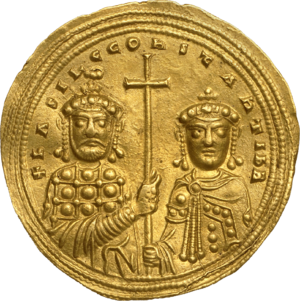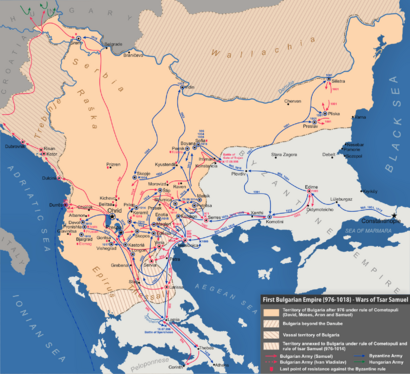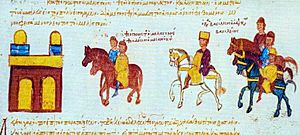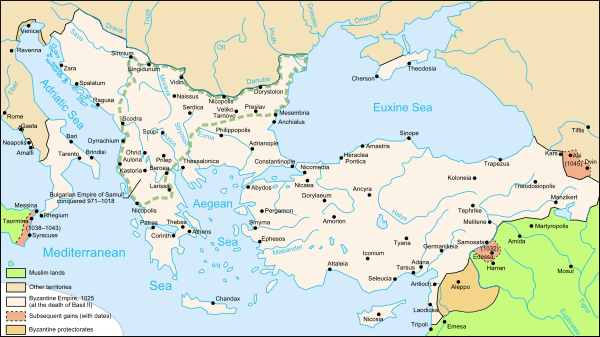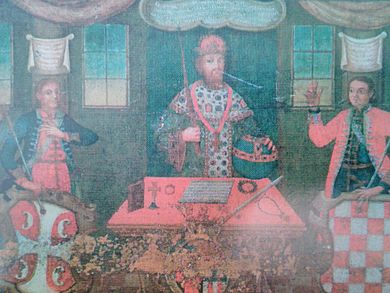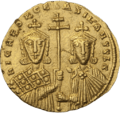Basil II facts for kids
Quick facts for kids Basil II |
|
|---|---|
| Emperor and Autocrat of the Romans | |

Replicated depiction of Basil II from his Menologion, National Historical Museum
|
|
| Byzantine emperor | |
| Reign | 10 January 976 – 15 December 1025 |
| Coronation | 22 April 960 as co-emperor |
| Predecessor | John I Tzimiskes |
| Successor | Constantine VIII |
| Born | 958 Constantinople, Byzantine Empire (modern-day Istanbul, Turkey) |
| Died | 15 December 1025 (aged 67) Constantinople, Byzantine Empire |
| Burial | Church of St. John the Theologian, Constantinople |
| Greek | Βασίλειος |
| Dynasty | Macedonian |
| Father | Romanos II |
| Mother | Theophano |
| Religion | Chalcedonian Christianity |
Basil II Porphyrogenitus (Greek: Βασίλειος Πορφυρογέννητος; 958 – 15 December 1025) was a powerful Byzantine emperor. He was also known as the Bulgar Slayer (Greek: ὁ Βουλγαροκτόνος). Basil ruled the Byzantine Empire from 976 to 1025, which was almost 50 years! This made his reign the longest of any Roman emperor.
Basil and his brother Constantine VIII were crowned when they were very young. Their father, Romanos II, died in 963. Since they were too young to rule, two generals, Nikephoros Phokas and John Tzimiskes, took over. Basil finally became the main emperor in 976.
His early years were tough, with civil wars against powerful generals. But Basil managed to win these fights. After that, he focused on making the Byzantine Empire stronger and larger. He fought many wars, especially against the First Bulgarian Empire, which was a big enemy in Europe. He also made peace with the Fatimid Caliphate and expanded the empire into Crimea and Georgia.
Even though he was always at war, Basil was a great leader. He made sure the empire's treasury was full. He also reduced the power of rich land-owning families. One of his most important decisions was to offer his sister Anna Porphyrogenita to Vladimir I of Kiev. This led to the creation of the famous Varangian Guard, a special group of soldiers. This marriage also helped spread Christianity to the Kievan Rus'. Today, Basil is seen as a hero in Greece, but some Bulgarians dislike him because of his wars against them.
Contents
Basil II's Personality
Michael Psellos, a historian who lived around Basil's time, described him. Basil was a strong figure, even though he was shorter than average. He had light-blue eyes and thick side whiskers. He often rolled his whiskers when he was thinking or angry.
Basil was not a fancy person. He didn't care much for the grand ceremonies of the Imperial court. He usually wore a simple, dark-purple robe with few jewels. He was also a very good administrator. He made sure the empire had plenty of money. Some historians say he didn't care much for books or learning. He was more of a man of action.
Early Life and Becoming Emperor
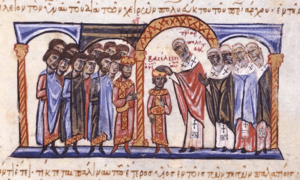
Basil II was born in 958. He was a porphyrogennetos, which meant he was born while his father was the reigning emperor. This was a special title. His father, Romanos II, made Basil a co-emperor in 960. His younger brother, Constantine, also became co-emperor later.
When Romanos II died in 963, Basil and Constantine were too young to rule alone. So, their mother, Theophano, was supposed to be in charge. But real power went to a powerful official named Joseph Bringas. Theophano didn't trust Bringas. Another powerful general, Nikephoros Phokas, marched on Constantinople. He became emperor in 963 and married Theophano.
Nikephoros Phokas was later murdered by his nephew, John Tzimiskes, who then became emperor. John I died in 976. That's when Basil II finally became the main emperor and took full control.
Basil's Rule: Wars and Alliances
Basil was a very skilled soldier and a strong leader. At first, a clever politician named Basil Lekapenos ran the government. Lekapenos hoped the young emperors would be his puppets. But Basil waited and learned about running the empire and leading the army.
Two powerful generals, Bardas Skleros and Bardas Phokas, rebelled against Basil. They wanted to take his place. Basil, showing his tough side, led his army himself to stop these rebellions. He got help from 12,000 soldiers from Georgia. The rebellions ended in 989.
These civil wars taught Basil a lot. He learned to be careful about powerful governors and generals. He also learned to keep his plans secret.
Alliance with Kievan Rus'
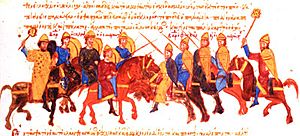
To defeat the rebels, Basil made an important alliance. He teamed up with Prince Vladimir I of Kiev. Vladimir had captured a Byzantine city called Chersonesus in Crimea. Vladimir offered to give Chersonesos back and send 6,000 of his best soldiers to help Basil.
In return, Vladimir wanted to marry Basil's younger sister, Anna. Basil was hesitant at first because Byzantines saw people from Northern Europe as "barbarians." Anna also didn't want to marry a barbarian ruler.
But Vladimir promised to become a Christian and convert his people. Basil finally agreed. Vladimir and Anna were married in 989. The Rus' warriors joined Basil's army and became the famous Varangian Guard. This marriage was very important. It helped spread Christianity and Byzantine culture to what would become Russia.
Campaigns Against the Fatimid Caliphate
After dealing with problems at home, Basil focused on other enemies. The Byzantine Empire had lost some land in the east to the Fatimid Caliphate. In 987–988, a peace treaty was signed. It allowed for prisoner exchanges and protected Christians under Fatimid rule.
However, the peace didn't last. The Fatimids attacked the city of Aleppo, which was protected by the Byzantines. Basil quickly led his army to Aleppo in 995. His sudden arrival scared the Fatimid army, and they retreated without a fight.
Warfare continued for a few more years. In 998, the Byzantines lost a battle at Apamea. This made Basil return to Syria in 999. He raided some areas but couldn't capture major cities. Finally, in 1000, a ten-year peace treaty was signed. This brought peace to the eastern border for a while.
Conquering Bulgaria
Basil wanted to get back lands that the Byzantine Empire had lost. His biggest enemy was Samuel of Bulgaria. The Bulgarians had been raiding Byzantine lands since 976. Basil led a large army into Bulgaria in 986 but suffered a defeat.
While Basil was busy with other wars, Samuel expanded his rule. He controlled a large area from the Adriatic Sea to the Black Sea. In 996, a Byzantine general defeated a Bulgarian army in Greece.
Starting in 1000, Basil focused all his efforts on conquering Bulgaria. He fought with great determination. In 1000, Byzantine generals captured the old Bulgarian capital, Preslav. In 1001, Basil took control of several towns. He cut off communications between Samuel's main lands and the Danube River.
After a long siege, Basil captured the city of Vidin. Samuel tried to counter-attack by raiding the Byzantine city of Adrianople. But Basil's army intercepted Samuel near Skopje, defeated the Bulgarians, and got the stolen goods back. Skopje surrendered to Basil.

In 1014, Basil launched a final big campaign. On July 29, 1014, at the Battle of Kleidion, Basil and his general outsmarted the Bulgarian army. Samuel escaped but died a few months later from a stroke.
Bulgaria continued to fight for four more years, but in 1018, it finally surrendered. This victory meant the Byzantine Empire controlled the Danube River border again, something that hadn't happened in 400 years. Basil treated the defeated Bulgarians fairly, giving many leaders important positions. He wanted to bring them into Byzantine society.
Before returning to Constantinople, Basil celebrated his victory in Athens. He was very smart in how he handled the Bulgarians. He even let them pay taxes with goods instead of money. This helped keep them happy for a while.
Campaigns in Georgia and Armenia
Basil also fought in the Caucasus region. He helped a Georgian prince, David III of Tao, who later promised his lands to Basil. In 1001, after David's death, Basil took control of these areas.
However, the Georgian king, George I, wanted these lands back. He formed an alliance with the Fatimid caliph. Basil was busy fighting the Bulgarians, so he couldn't respond right away.

Once Bulgaria was conquered in 1018, Basil led his army against Georgia. In late 1021, Basil attacked the Georgians and their allies. He won a tough battle and took more land. George I was forced to sign a treaty. He gave up several regions and sent his young son, Bagrat, as a hostage to Basil.
Basil also gained control of the Armenian kingdom of Vaspurakan in 1021. He created a strong border in these mountain areas.
Basil's Policies and Army

Basil II was very popular with his army. He spent most of his time campaigning with them, not just giving orders from Constantinople. He lived like a soldier, eating the same food as everyone else. He also took care of the children of dead army officers, giving them homes and education. Many of these children later became his soldiers and officers.
Basil also cared about ordinary farmers. He made laws to protect small landowners and lowered their taxes. This made them happy and helped provide supplies and soldiers for his army. He also made a law that forced rich landowners to help pay the taxes of poorer people. This was not popular with the wealthy, but Basil kept it.
By the end of his reign, Basil had collected a huge amount of gold for the empire's treasury. This was because of his careful management. Even though he tried to limit the power of the rich families, they became powerful again after he died.
Later Life and Death
Basil II was planning a military trip to take back the island of Sicily when he died on December 15, 1025. He had the longest reign of any Byzantine or Roman emperor.
When he died, the Byzantine Empire was at its largest in 400 years. It stretched from southern Italy to the Caucasus mountains and from the Danube River to the Middle East.
Basil wanted to be buried in a specific church outside Constantinople. His tomb had an inscription that celebrated his many campaigns and victories. It said he protected the "children of the New Rome" (the Byzantine Empire) and campaigned in both the West and East.
Basil's Legacy
Basil II's reign was one of the most important in Byzantine history. His constant military campaigns made the Byzantine Empire very powerful. By securing the Danube border and conquering Bulgaria, he brought peace to the empire's European lands. This kept big cities, including Constantinople, safe from attacks.
The Varangian Guard he created was an elite group of mercenary soldiers. They were very effective in battle and feared by the empire's enemies.
During this time, there was a "Macedonian Renaissance." This was a period when people became very interested in classical Greek learning. They studied ancient Greek philosophy and art. The library at the University of Constantinople grew a lot. Even though Basil wasn't a scholar, he helped build churches and monasteries.
Basil II didn't have any children to take over the throne. So, his brother Constantine and his family became the next rulers. They weren't as strong as Basil. However, the empire still did well for about 50 years after Basil's death. This was because the treasury was full, and the borders were safe. The Byzantine Empire was the most powerful state of its time.
Sadly, many of Basil's achievements were lost quickly after his death. Later emperors were not as strong. The empire faced new threats, especially from the Seljuk Empire.
Basil in Modern Culture
- In Bulgaria, some people see Basil II as a "murderer of Bulgarians" because of his harsh wars. But in Greece, he is a national hero.
- Many books have been written about Basil II. For example, Basil Bulgaroktonos (1964) by Kostas Kyriazis is a popular historical novel.
- Blood Feud (1976) by Rosemary Sutcliff tells Basil's story from the point of view of a Varangian Guard member.
- Penelope Delta's novel Ton Kairo tou Voulgaroktonou (In the Years of the Bulgar-Slayer) is also set during his reign.
- Basil II is a leader for the Byzantine Empire in the video game Civilization VI.
- There is a comic book series about him called Basil Basileus.
See also
 In Spanish: Basilio II para niños
In Spanish: Basilio II para niños
Images for kids
-
Coin of Nikephoros II (left) and Basil II (right)
-
The Armenian prince Gregory Taronites is ambushed by the Bulgarians near Thessalonica.
-
The Pontic steppes, c. 1015. The areas in blue are those possibly still under Khazar control.


